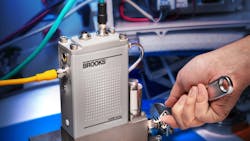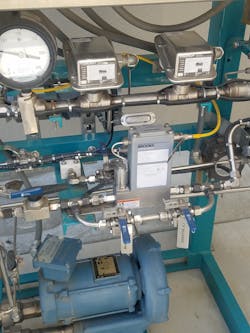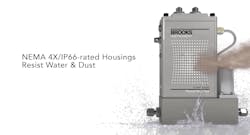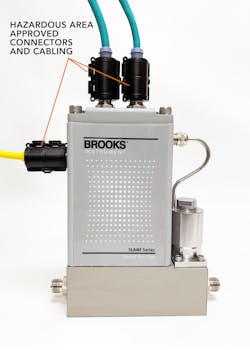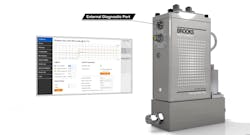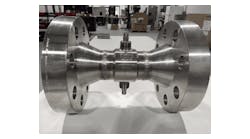Chemical plants and petrochemical refineries have some of the most hazardous operating conditions of any industry. As a result, stringent safety procedures and protocols have been established to protect both people and production systems from explosions that can happen from running process equipment. This equipment includes mass flow controllers (MFCs).
MFCs are instruments used to measure and control the flow of gases in a process where factors such as flow range, gas conditions, flow accuracy and device communication are important to successful plant operation.
The latest generation of digital MFCs is widely used in chemical and petrochemical facilities due to their precise control and long-term stability for accurate gas flow. They are commonly found in research labs and pilot plants, where exact measurement and control of process gasses are necessary as new products are developed or new refining processes are evaluated and scaled-up prior to full production.
When selecting and using precision MFC instrumentation in these environments, it is critical to understand how this equipment is designed in order to specifically meet — or exceed — applicable standards and classification approvals. It is also important to consider how the MFC is engineered for these kinds of industrial environments: how rugged it is; how well it can stand up to environmental conditions if installed on outdoor process equipment; how much wear and tear it can take and still retain precise, stable flow control over its life cycle.
Understanding hazardous conditions and classifications
Hazardous environments can host a concentration of flammable gases, vapors, mists or combustible dusts or fibers. These include situations where an explosive chemical or gas is being produced, stored or transported. The risk is twofold: accidental leakage of these explosive gases or dusts or the gradual buildup of combustible dusts could be ignited by the operation of electronic devices like MFCs.
In some installations, standard MFCs are housed in separate enclosures designed to provide protection from outside hazards. However, this can lead to additional costs — due to the enclosure itself as well as the installation and expenditures related to connecting gas feed lines and wiring for power and device communications. A better alternative is to consider using MFCs designed specifically for hazardous environments.
When assessing whether an MFC can be safely used in a hazardous environment, it is necessary to understand key classification standards and labeling to determine if the device is right for your needs.
The Class/Division system is used in North America (the rest of the world operates under a similar Zone system). An environment’s Class defines the nature of the hazard, such as gas, vapor, dust and fibers; the Division identifies the probability of the hazardous material being present. There are three classes, with Class 1 covering the flammable gases or vapors present in chemical or petrochemical settings, so it is important to specify an MFC that is engineered to operate in Class 1 conditions. Third-party rating organizations such as UL conduct various tests to assign the classification.
For MFCs, one critical test assesses the potential for autoignition of volatiles that could result from the heat generated by the MFC’s electronics. The rating agency powers the device and operates it at its highest power draw to determine if the heat could ignite any vapors, such as ethylene, hydrogen, acetylene or others. Since there are different autoignition temperatures for different gases, a Class 1 rating for an MFC will include additional information specifying which volatiles the MFC has been tested for.
MFCs for hazardous areas also typically receive IP and NEMA ratings. The IP rating identifies the level of ingress protection provided by an enclosure or housing from both dust and liquids. The NEMA rating defines the enclosure’s ability to withstand various environmental conditions.
For MFC products, the most common classifications are NEMA 4/4x, IP65, IP66 and IP67. For example, IP66-rated MFC housings are dust-tight and protected against heavy water jet spray, which could degrade the housings and potentially allow ingress of explosive gases or dust that could potentially ignite.
In addition, MFCs with IP66-rated housings are much more rugged and designed to provide longer operating life cycles even if exposed to moisture from washdown conditions or weather. That makes IP66-rated MFCs reliable devices for use in outdoor process equipment without requiring additional housing or enclosures.
Keeping track of the different ratings and certifications can be challenging. To help ensure you are selecting an MFC that complies with these requirements, it makes sense to work with technology suppliers that have extensive knowledge about these ratings and standards and can help guide you in specifying the right device for a given application. Brooks Instrument, for example, has a dedicated certifications resource webpage to help users understand approvals for flow control instrumentation.
Key features protecting MFCs in hazardous environments
A critical safety area to consider is the design of the electrical and communications connectors on the MFC. They should be designed so they cannot be easily or accidentally disconnected, to prevent a momentary electrical discharge that can cause a spark.
Brooks Instrument, for example, uses special connectors for hazardous-area MFCs that feature simple locking mechanisms that need to be opened with a tool to ensure the connections are only open when there are no gases or dust concentrations present. In addition, it is also important to use communications and power cabling that is certified for hazardous areas. If the cabling is not approved for hazardous environments, it would need to be run through conduits, adding significant equipment and installation costs and making routine access to the MFCs for service and maintenance more time-consuming.
Long-term flow accuracy
In MFCs, a key performance characteristic is long-term stability, sometimes referred to as low long-term drift, which represents consistent and accurate gas flow. MFCs are typically calibrated when first delivered from the manufacturer, and end users typically benchmark their stability when the device is first installed.
In some chemical and petrochemical research and pilot plants, a common practice with devices like MFCs is to remove and test/recalibrate them during maintenance intervals or when they change the process gas the MFC is controlling due to running new processes. However, these recalibration efforts take time and can sideline a system if there are no spare MFCs to replace the one being calibrated. Be sure to work with MFC instrument providers that include a long-term stability specification for the device.
Choosing MFCs with long-term stability specifications can help end users avoid the time and cost of recalibration. For example, the Brooks Instrument digital SLAMf MFC, which is specially built to operate in the harshest environments with a NEMA 4X/IP66 enclosure rating, features a long-term certified flow accuracy of ±0.6% of SP.
An additional useful feature to look for on a digital MFC is a zero-drift diagnostic. This is a digital test users can access to confirm that the device measurement is not drifting outside the specification, even though the device might have been in use for one or two years. This lets the end user eliminate unnecessary recalibrations from the maintenance schedule and recalibrate only when needed.
Advanced communications, more diagnostic capabilities
Industry 4.0 technology is becoming more prevalent in the chemical and petrochemical industries. When selecting MFCs for hazardous-area applications, it is important to also consider the digital communications, sensor and other built-in diagnostic capabilities available on the MFCs you are specifying.
High-speed digital communication protocols such as EtherNet/IP and PROFINET are becoming widely adopted within the process control architectures in both industries. Unlike MFCs from past generations that only supported analog interfaces, MFCs with high-speed digital interfaces make it easier to supply critical MFC performance data — such as flow rate, device temperature, valve position, sensor condition and other data — in real time.
This lets end users — particularly in research facilities and pilot plants that are testing new processes and need as much process instrumentation data as they can get — incorporate MFC performance data into their process management protocols.
Leading suppliers of hazardous-area MFCs provide a full suite of diagnostics that measure and track the performance and accuracy of the device and correlate the MFC data with other process results for more detailed analysis.
These MFCs also feature multiple alarms that give researchers and process engineers sensor data tied to the gas delivery process. Alarms like Totalizer Overflow and Setpoint Deviation can not only alert users to conditions that fall outside process gas delivery thresholds but they can also help point to potential issues within the gas delivery system or other process equipment.
For example, a Restricted Flow Alarm alerts the user when the MFC is not able to achieve the desired set point flow rate. This could be due to a gas bottle that is empty or near empty, a faulty gas regulator that isn’t maintaining pressure at an appropriate level or a clogged filter causing a restriction in the line.
Some companies, like Brooks Instrument, support these capabilities with a standalone software package and communications interface that lets users access the MFC and manage the alarms from a laptop or tablet, even while the device is running.
Putting it all together
MFCs are valuable and effective instruments for measuring and controlling process gases in hazardous-area chemical and petrochemical plant operations. Understanding which locations in a facility are designated hazardous areas, and the level of protection needed with the device, is critical to selecting devices that are both reliable and safe.
In addition, features such as long-term stability, rugged design and support for high-speed digital communications and diagnostic capabilities are equally important to ensuring the device you choose is reliable, accurate and repeatable over its life cycle. Working with technology suppliers that have extensive knowledge about these regulatory requirements and standards can help ensure you select the right device for your applications.
Steve Kannengieszer is a global marketing director with Brooks Instrument, focused on mass flow controllers for a variety of industrial markets. He has more than 30 years of experience in product development and management of instrumentation.
Steve Kannengieszer | Global marketing director with Brooks Instrument
Steve Kannengieszer is a global marketing director with Brooks Instrument, focused on mass flow controllers for a variety of industrial markets. He has more than 30 years of experience in product development and management of instrumentation.
